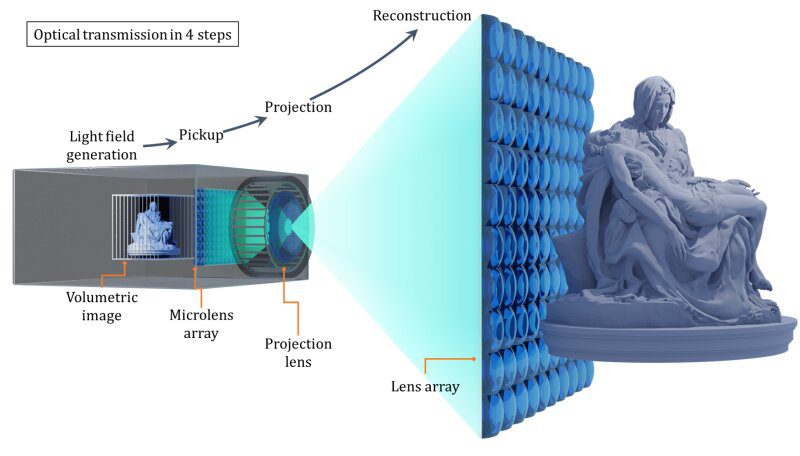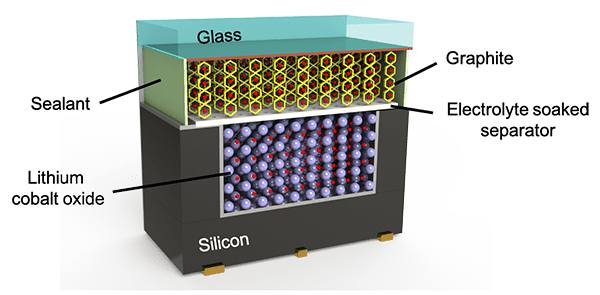
The new display optically transforms the object display volume generated from the multifocal display into the projection volume for integral imaging by automatically mapping the rays through a microlens array (optical pickup). The transformed information can be enlarged to the large screen through a projection lens. After the projection, the object display volume is reconstructed, passing through another lens array in a similar manner to the existing integral imaging system.
Credit: Byoungho Lee, Seoul National University
Projection approach could enable large, high-definition 3D images for digital signs and immersive experiences
Researchers have developed a prototype display that uses projection to create large-scale 3D images with ultra-high definition. The new approach helps overcome the limitations of light-field projection, which can create natural-looking 3D images that don’t require special 3D glasses for viewing.
“Our optical design could make it practical to replace 2D flat panel displays with 3D images for digital signs, entertainment, education and other applications where 3D images provide a significant enhancement,” said research team leader Byoungho Lee from Seoul National University in Korea. “Our design could also be modified to provide immersive experiences in movie theaters, for example.”
In The Optical Society (OSA) journal Optics Letters, the researchers describe how they combine two different light-field display technologies to project large-scale 3D images with almost diffraction-limited resolution. The new display is autostereoscopic, which means that it produces different 3D images so that the image can be viewed from various angles.
“We developed a way to carry out all the display processes optically without any digital processing,” said Lee. “This compensates for the limitations of each display technology to allow the creation of high-resolution 3D images on a large screen.”
Combining technologies
Light-field displays work by reproducing light that is reflected from an object in a way that corresponds to the actual visible position. Because autostereoscopic light field displays produce different images for different viewing angles, they require a huge amount of information to be processed. This demand creates a tradeoff between resolution and the size of the displayed image because the hardware of the display gets overwhelmed by the amount of information required.
To overcome this limitation, the researchers designed a new optical configuration that combines a multifocal display with integral imaging. Typically, a multifocal display can generate a high-quality volumetric image, but it is technically difficult to implement on a large-screen system. On the other hand, integral imaging is better at enlarging images.
In the new design, the multifocal display generates a high-resolution 3D, or volumetric, scene while the integral imaging technology enlarges it for viewing on a large screen. The information conversion between the multifocal display and integral imaging is all performed optically without any digital processing.
“Our method goes beyond merely combining two existing methods to achieving an ultrahigh-definition volumetric light-field display with almost diffraction-limited resolution,” said Lee. “We also found a way to effectively resolve the difficulty of enlarging a volumetric scene and overcame problems with information loss that tend to affect integral imaging.”
Large and high-resolution 3D images
After verifying the resolution of their prototype system, the researchers qualitatively confirmed that a volumetric image was reconstructed. The tests showed that the prototype can synthesize a volumetric image of 21.4 cm x 21.4 cm x 32 cm, which is equivalent to 28.6 megapixels and 36 times higher resolution than the original image.
“Our approach is very efficient at processing information, which enables a low computing cost as well as simple, high-quality, real-time system configuration,” said Lee. “The optical design can also be seamlessly integrated with various techniques used in existing light-field displays.”
The researchers are now working to optimize the optics and further reduce the complexity of the multifocal display to make the projector more compact. They note that because the system is a fusion of two different technologies, the performance of their proposed system will likely improve as each technology develops.
Original Article: New Technology Lays Groundwork for Large-Scale, High-Resolution 3D Displays
More from: Seoul National University | The Optical Society
The Latest Updates from Bing News & Google News
Go deeper with Bing News on:
High-resolution 3D images
- FFF 3D Printing: Can New Nozzle Technology Replace Resin Printers?on May 3, 2024 at 2:47 pm
Do you need a resin 3D printer when FFF devices now approach similar levels of surface quality? That sounds like a crazy question. For many years it’s been 3D print gospel that resin equipment ...
- Purdue University 3D microscope innovations (IMAGE)on April 30, 2024 at 7:43 am
Liming Chen, who will earn his PhD in mechanical engineering from Purdue in May 2024, operates a 3D microscope, which uses an optical technique called fringe projection to create a high-resolution 3D ...
- First high-resolution 3D nanoscale chemical imaging achieved with multi-modal tomographyon April 30, 2024 at 6:21 am
By exploiting a smart learning algorithm that fuses two microscopy signals, University of Michigan researchers have accomplished high-resolution, efficient 3D chemical imaging for the first time at ...
- Smart learning algorithm achieves first high-res 3D chemical imaging at one-nanometer scaleon April 29, 2024 at 5:00 pm
"By leveraging our knowledge of the imaging process and taking a new approach to tomographic reconstruction, we are now able to simultaneously image structure and chemical composition with high ...
- Airborne single-photon lidar system achieves high-resolution 3D imagingon April 25, 2024 at 7:03 am
WASHINGTON — Researchers have developed a compact and lightweight single-photon airborne lidar system that can acquire high-resolution 3D images with a low-power laser. This advance could make ...
Go deeper with Google Headlines on:
High-resolution 3D images
[google_news title=”” keyword=”high-resolution 3D images” num_posts=”5″ blurb_length=”0″ show_thumb=”left”]
Go deeper with Bing News on:
Multifocal display
- Apple Studio Display vs Samsung ViewFinity S9on April 19, 2024 at 12:39 pm
After the Apple Thunderbolt display was canceled in 2016, the Apple-endorsed display became the LG UltraFine 27-inch 5K (full review) and 21.5-inch 4K – later replaced by the 24-inch 4K model.
- New HomePod part leak shows off glossy display coveron April 17, 2024 at 5:00 pm
Apple has been long rumored to be working on a HomePod with a full touch display that can show more than a waveform, and a new leak offers a look at the potential glossy display glass. An alleged ...
- The best car heads-up display for 2024on April 16, 2024 at 4:47 am
A good heads-up display can place all the essential stuff right in your line of sight — and without blocking your view of the road ahead. There are a lot of car heads-up displays you can buy ...
- Multifocal Fixed Drug Eruption Due to Celecoxibon April 14, 2024 at 5:00 pm
Multifocal fixed drug eruption (MFDE) is a rare cutaneous disorder characterized by numerous lesions relapsing on multiple sites each time the causative drug or a chemically related drug is taken ...
- These Techie Reading Glasses Are Expensive, but May Hold the Key to Future Eyewearon March 29, 2024 at 7:00 am
In New York City this month, this was on display fully at the Vison Expo East ... combinations of eyewear purposes, like standard multifocal or progressive glasses that include part distance ...
Go deeper with Google Headlines on:
Multifocal display
[google_news title=”” keyword=”multifocal display” num_posts=”5″ blurb_length=”0″ show_thumb=”left”]










